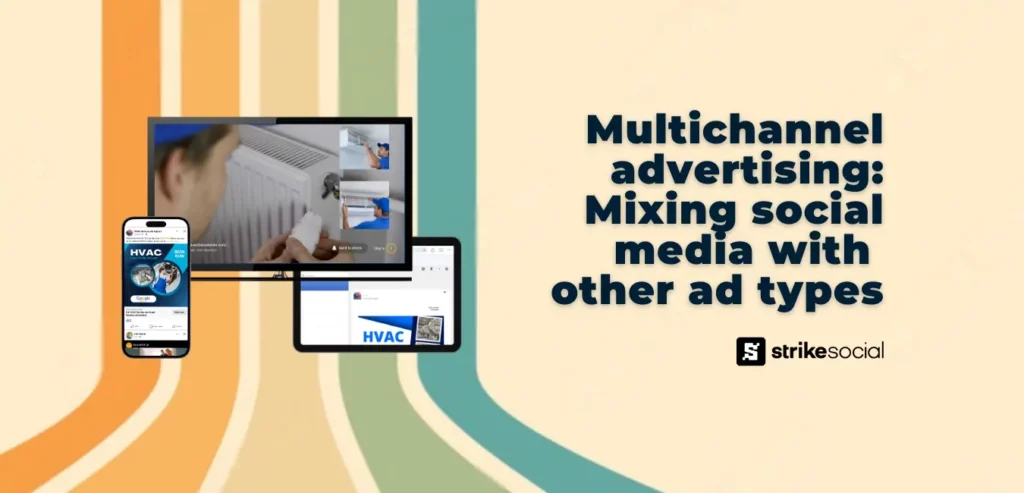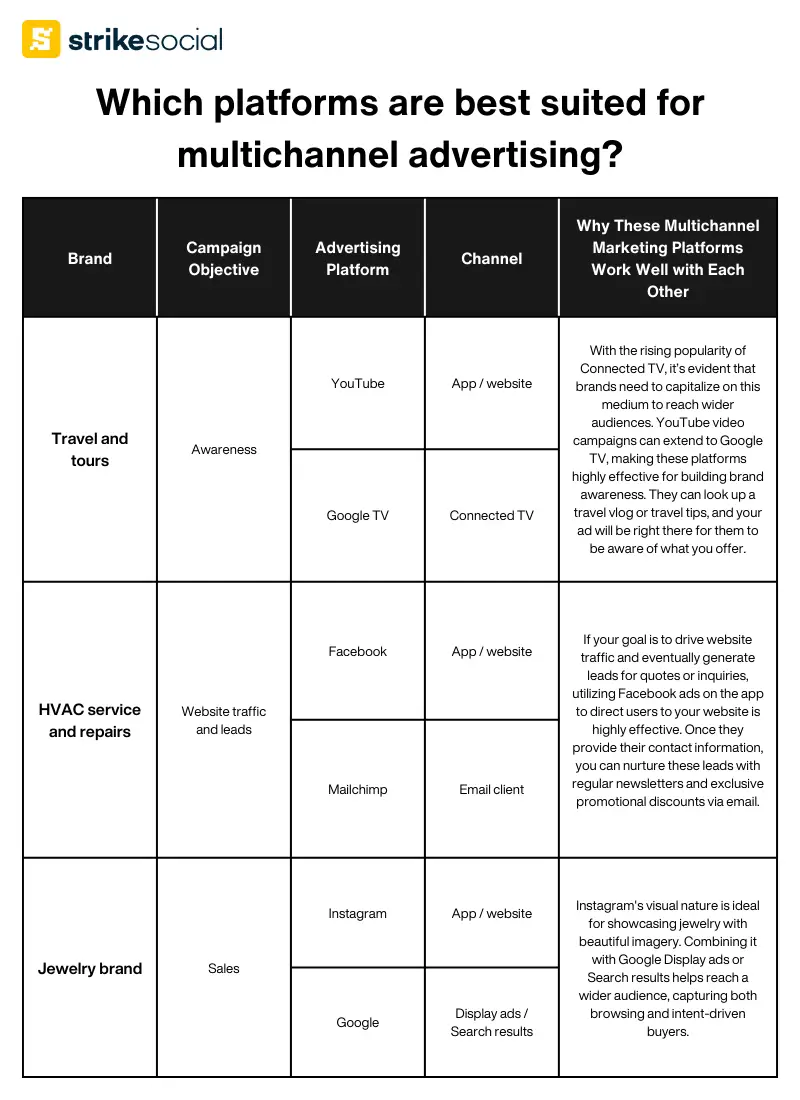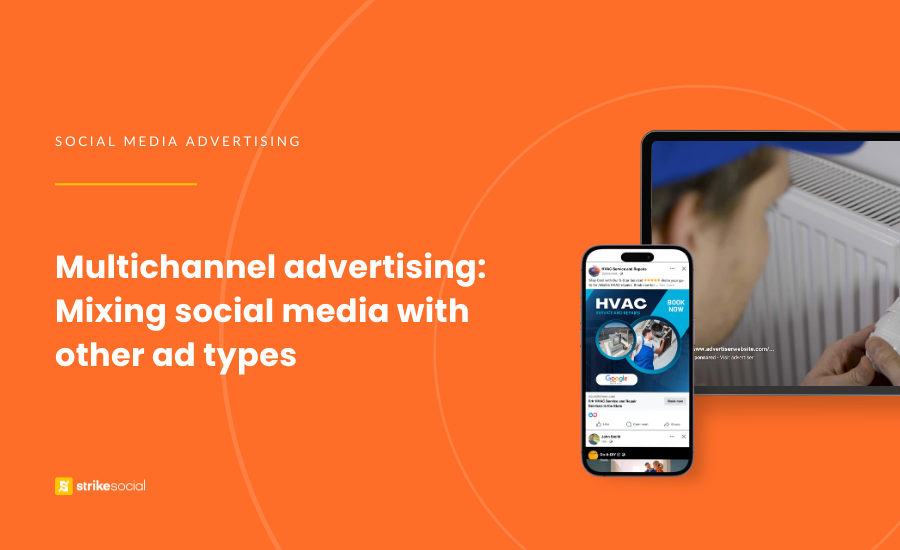Strike Overview
- A multichannel advertising strategy incorporating social media is highly essential as consumers navigate multiple touchpoints and channels before making a purchase.
- Consumers today are more self-reliant, often researching products independently. With U.S. adults spending about 5.5 hours daily on smartphones, they engage with various platforms like YouTube, Facebook, and Instagram throughout their day.
- How can you create a multichannel advertising strategy to keep your brand at the forefront of customers’ brains when the time to buy comes? Take a look at how multichannel marketing works and understand how you can use it to your benefit.
Jump to Section
Get exclusive content on paid social media.
Join our mailing list for the latest updates.

This post was updated in August 2024 to provide you with the latest information.
Multichannel Advertising — How to Mix Social Media with Other Ad Types
As the path to conversion becomes more complex due to the increasing number of sources of information and channels for communication available, consumers have to be exposed to different messages to keep your brand in mind and convert. That is when multichannel marketing comes in handy.
This brings a wide array of possibilities for brands to reach potential customers through multichannel marketing, including social media advertising. Paid social media can effectively complement and enhance other marketing strategies, making it an invaluable tool for reaching your target audience.
Why multichannel advertising?
It’s been shown that multi-channel customers spend up to three times more than single-channel users. This drives home the fact that repetition is key, and implementing a multichannel marketing campaign provides multiple outlets for your message without being annoying or intrusive. That, along with advertisers seeing a 250% higher purchase rate when using a multichannel social media strategy, makes for a pretty convincing argument.
Various ad types within social media platforms also offer a deeper look into data marketers can use to analyze the behavior of potential customers and their preferred channels to improve response rates. For example, U.S. users spend approximately 33.1 minutes per day on Instagram, while YouTube users spend around 40 minutes daily watching various videos. These platforms offer a prime opportunity to get your brand in front of your target audience.
Social media has consistently proven to be an effective channel for engaging and attracting a captivated audience.
Further Reading

What’s the Perfect Social Media Ad Type to Promote your Brand?
When there are few ad formats to choose from, repetitive ads can lead to viewer fatigue, causing users to overlook your content. Choosing the right social media ad type can make your campaign stand out, grab attention, and deliver better results.
When should you use a multichannel marketing strategy?
Considering you need to be where your customers are and the need to reach your customers multiple times, multichannel marketing is the ideal strategy for any company looking to maximize opportunities to interact with prospective customers.
Remember, though, that each platform has different strengths. Multichannel advertising requires you to craft your ads to the specificities of each channel.
Which platforms are best suited for multichannel advertising?
Let’s examine the different advertising platforms and identify which multichannel social media marketing strategies work best with them. By looking at various examples and brand objectives, we can gain a clearer understanding.
Social platforms are suited for messages that are designed to go viral or that use a more informal tone, similar to what you would use to speak to a friend. When using paid social as part of a multichannel marketing strategy, remember to adapt your ads to the platform you are using.

On the other hand, mixing in channels like email and SMS marketing allows you to build a deeper connection with your audience by keeping them informed about new products or services and offering exclusive promotions for upcoming holidays, such as Halloween specials or Thanksgiving discounts. Another growing channel is Connected TV, which helps you reach broader audiences and enhance brand recall by introducing your brand to new, yet still highly-targeted, viewers.
How much does multichannel advertising cost?
The cost of multichannel advertising campaigns will depend largely on the channels you ultimately decide to use. Traditional linear TV tends to be more expensive, while Connected TV can be more cost-effective due to its distribution across multiple digital channels, maximizing audience reach.
Social media advertising costs can be lower but vary significantly based on audience targeting and bidding strategies. More personalized multichannel marketing plans, like SMS and email marketing, also have different pricing structures, often based on the size of your database and the frequency of mailouts or blasts.
Smaller businesses may even use dedicated multichannel platforms like Brevo and its alternatives, such as SendPulse, to save money by utilizing free plans. SendPulse, for example, comes with 15.000 free marketing emails every month, and Brevo offers 300 emails daily.
No advertiser has the particular desire to spend more of their budget, but seeing larger returns than the initial investment makes it a savvy business decision because the advertiser is making back more than what they spent.
Further Reading

How to Calculate ROI and ROAS on YouTube
To assess the success of your YouTube ads, know how to compute ROI (return on investment) and ROAS (return on advertising spend). These metrics provide insights into how effectively your ad spend is translating into returns and guide your campaign decisions.
Goals that can be met through multichannel campaigns
By spreading your message across channels that customers frequent, multichannel messaging provides more opportunities to reach them. Multichannel advertising campaigns have seen many positive results in areas other than their ROI and ROAS. The short list is provided below.
- 40% of shoppers prefer to research brands online before making a purchase, driving more traffic to your site.
- With 71% of shoppers using their phones for brand research, multichannel campaigns can lead to significant increases in mobile visits.
- Up to 89% retention rates can be achieved, with 86% of marketers reporting that multichannel advertising leads to more completed video views.
- Brands using 3-4 marketing channels see wider audience reach, with 51% of brands employing up to 8 channels for maximum exposure.
- Multichannel advertising can drive up to a 300% increase in engagement compared to single or dual-channel strategies.
- Brands using both social media advertising and television see a 12-point lift in brand recall by spreading their marketing messages across different channels.
Multichannel advertising brings in multi-level benefits
All in all, multichannel advertising provides huge benefits to the advertiser without a huge increase in cost. With social media generally having a lower cost than TV ads, it’s a no-brainer with the returns it provides that it should be included in the advertising mix.








